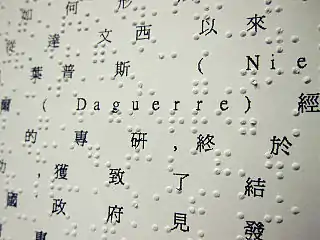Taiwanese Braille
Taiwanese Braille is the braille script used in Taiwan for Taiwanese Mandarin (Guoyu).[1] Although based marginally on international braille, most consonants have been reassigned;[2] also, like Chinese Braille, Taiwanese Braille is a semi-syllabary.
| Taiwanese Braille ⠅⠒⠂⠳⠈⠀⠙⠞⠈⠓⠱⠐ | |
|---|---|
| Script type | |
Print basis | Zhuyin |
| Languages | Standard Mandarin |
| Related scripts | |
Parent systems | Night writing
|

An example is,
| 國 | 語 | 點 | 字 | 記 | 號 | |||||||||||
| ㄍ | ㄨㄛ | ˊ | ㄩ | ˇ | ㄉ | ㄧㄢ | ˇ | ㄗ | ㄭ | ˋ | ㄐ | ㄧ | ˋ | ㄏ | ㄠ | ˋ |
| guó | yǔ | diǎn | zì | jì | hào | |||||||||||
Charts
Initials
| Zhuyin | ㄅ | ㄆ | ㄇ | ㄈ | ㄉ | ㄊ | ㄋ | ㄌ | ㄍ | ㄎ | ㄏ | ㄐ | ㄑ | ㄒ | ㄓ | ㄔ | ㄕ | ㄖ | ㄗ | ㄘ | ㄙ |
|---|---|---|---|---|---|---|---|---|---|---|---|---|---|---|---|---|---|---|---|---|---|
| Pinyin | b | p | m | f | d | t | n | l | g | k | h | j | q | x | zh | ch | sh | r | z | c | s |
| Braille |
The braille letters for zhuyin/pinyin ㄍ g (/k/), ㄘ c (/tsʰ/), and ㄙ s (/s/) double for the alveolo-palatal consonants ㄐ j (/tɕ/), ㄑ q (/tɕʰ/), and ㄒ x (/ɕ/).[3] The latter are followed by close front vowels, namely ㄧ i (/i/) and ㄩ ü (/y/), so the distinction between g, c, s (or z, k, h) and j, q, x in zhuyin and pinyin is redundant.
Medial + rime
Each medial + rime in zhuyin is written with a single letter in braille.
| Zhuyin | ㄚ | ㄛ | ㄜ | ㄝ | ㄞ | ㄟ | ㄠ | ㄡ | ㄢ | ㄣ | ㄤ | ㄥ | |
|---|---|---|---|---|---|---|---|---|---|---|---|---|---|
| Pinyin | -i/er | a | o | e | ê | ai | ei | ao | ou | an | en | ang | eng |
| Braille | |||||||||||||
| Zhuyin | ㄧ | ㄧㄚ | ㄧㄛ | ㄧㄝ | ㄧㄞ | ㄧㄠ | ㄧㄡ | ㄧㄢ | ㄧㄣ | ㄧㄤ | ㄧㄥ | ||
| Pinyin | i | ia | io | ie | iai | iao | iu | ian | in | iang | ing | ||
| Braille | |||||||||||||
| Zhuyin | ㄨ | ㄨㄚ | ㄨㄛ | ㄨㄞ | ㄨㄟ | ㄨㄢ | ㄨㄣ | ㄨㄤ | ㄨㄥ | ||||
| Pinyin | u | ua | uo | uai | ui | uan | un | uang | ong | ||||
| Braille | |||||||||||||
| Zhuyin | ㄩ | ㄩㄝ | ㄩㄢ | ㄩㄣ | ㄩㄥ | ||||||||
| Pinyin | ü | üe | üan | ün | iong | ||||||||
| Braille | |||||||||||||
⠱ is used for both the empty rime ![]() -i ([ɨ]), which is not written in zhuyin, and the rime ㄦ er ([ɐɚ]). See for example 斯 sī (⠑⠱⠄) located above the word Daguerre in the image at right.
-i ([ɨ]), which is not written in zhuyin, and the rime ㄦ er ([ɐɚ]). See for example 斯 sī (⠑⠱⠄) located above the word Daguerre in the image at right.
References
- Not for Taiwanese Hokkien, which commonly goes by the name "Taiwanese"
- Only p m d n g c a e ê ü (from p m d n k j ä è dropped-e ü) approximate the French norm. Other letters have been reassigned so that the sets of letters in groups such as d t n l and g k h are similar in shape.
- [sic] One might expect ㄐ j (/tɕ/) to pair with ㄗ z (/ts/), by analogy with the others. Compare here, where the character 學 xué is rendered ⠑⠦⠂ "süé". Historically it could have been either. The principal behind the assignments seems to be that, of the historically appropriate pairs of letters g~z, k~c, and h~s, the letter with the fewer dots is used for j, q, x.
- "JAPANESE BRAILLE. : languagehat.com". languagehat.com. Retrieved 2022-02-27.
- 萬明美, 2001, 「視障教育」, 五南圖書出版股份有限公司, p. 74 ff